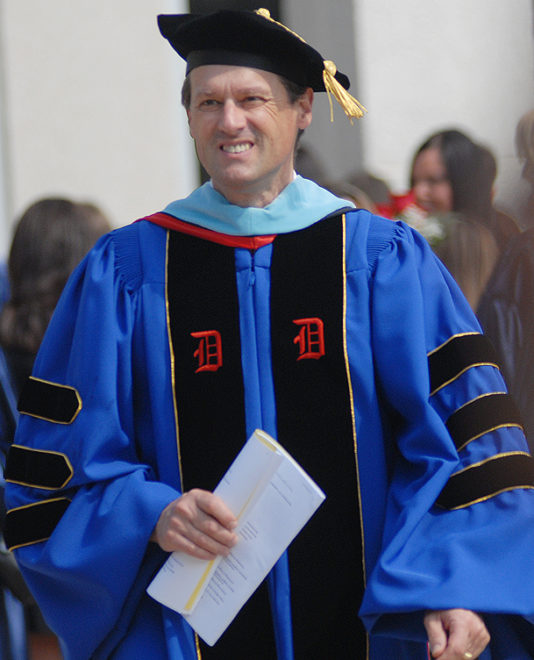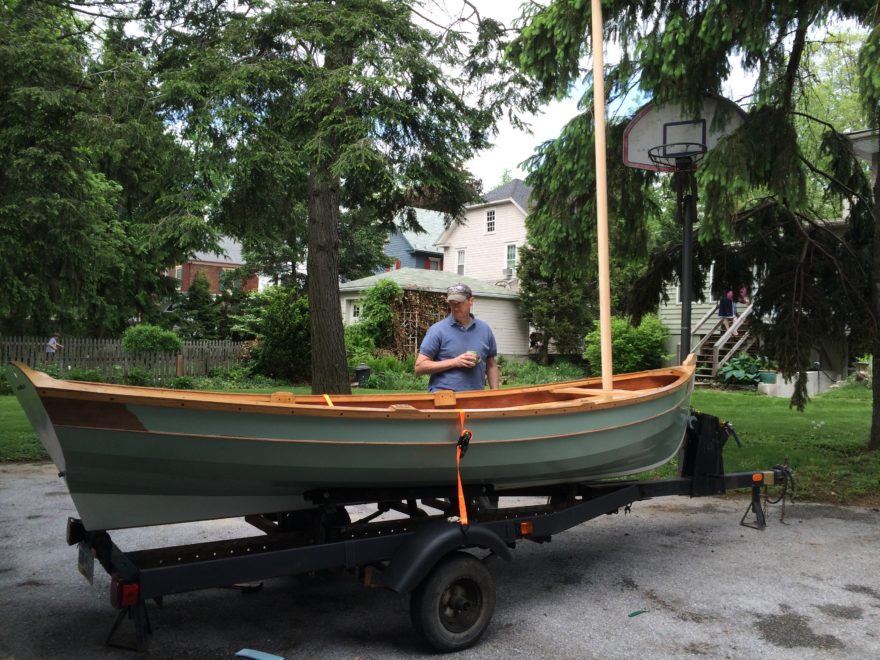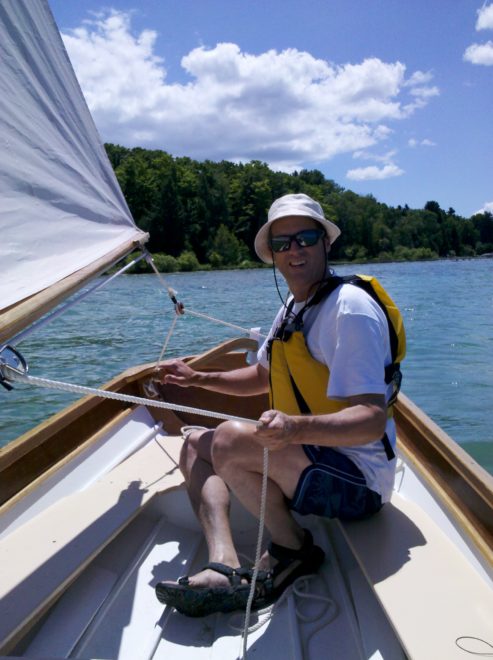Retirees have a well-established beachhead at Inland Seas. The formerly-employed can be found in every type of voluntary role, from maintaining grounds, to teaching lessons, to helping around the office. I’ve found a niche as a crew member, helping to sail the boat while volunteer instructors lead lessons for students and guests. In this little blog post, I will talk about how I connected with ISEA and how meaningful that connection has become.

I spent most of my working life as an educator, starting in migrant education in the Midwest, then teaching primary grades in Colorado, then serving as a principal and administrator before moving on to teach graduate school in Pennsylvania. That last position was my Goldilocks job: the balance of teaching, serving high-poverty school districts as a consultant, conducting research on the power of mentorships in the development of school leaders, and serving on university governance committees was just right for me. I was proud to help create a very successful doctoral program for current and aspiring school leaders, with an emphasis on developing equal opportunities for school-age students in low-economic and underserved communities.
Going North
But, the university was in Pennsylvania, and Northwest Michigan kept calling me up. My wife, Lynn Uhlmann, and I were fortunate enough to buy a house near Empire, where Lynn developed an art studio to support her painting. As she experienced ever-greater success showing her beautiful paintings around Michigan, I ended up spending more solo time holding down the fort in our big house in Pennsylvania. I occupied my extra time building a 14’ sailing skiff. A headline from the university’s undergraduate student newspaper in 2013 pretty much sums it up: “Diller Plans to Set Sail on the Great Lakes.” A year later, I hauled the boat, GRATEFUL, North, and indeed, launched her off the beach in Empire. Around the same time, my then 88-year-old parents sold their home downstate and moved to Traverse City, and one of our sons settled in the area. Finally, after 43 years of public service, I was ready to come North to stay. We sold the Pennsylvania house right at the beginning of the pandemic, and I made the eerie trip to Empire on a seemingly abandoned Turnpike with the last of our belongings and began to settle in.

Perma-cation
Settling in looked and felt a lot like being on permanent vacation. I stayed up late, slept late, worked on my sailing skills, bought another boat, built a shop in my polebarn, cut a lot of firewood… I did everything and anything I felt like doing, and practically nothing I didn’t feel compelled to do. It was great. During this time I also got reacquainted with Leelanau County, where I had vacationed since childhood and recorded many happy memories, but never lived for more than 10 days at a time. Somewhere in my travels, I stopped in at ISEA: I noticed the center and thought there might be a boat shop to visit. I picked up pamphlets and some time later made an appointment with Juliana to talk about what I could offer the organization. Yes, I was arrogant, and assumed that I might be able to help secure grants (I had had some success), or develop curriculum (again, some experience), or work in a boat shop. Juliana showed me around the center, and I realized that those organizationally necessary functions were very well covered, and the boat shop was on hold. But, would I consider training as a crew member? I took some time, most of the winter, to think it over.
During that winter my perma-cation mentality began to be confronted by a new reality: I missed my job at the university. It wasn’t the teaching, the research, or the university service; mostly, it was my colleagues down the hall, their commitment to teaching above all else, our lively lunches, heated discussions, shared inquiry, intellectual challenge, and more than occasional silliness. Yes, I even missed committee work. I found that I was feeling a bit adrift, without purpose. So, I filled out a volunteer application at ISEA, and joined in the video training sessions to become Crew-In-Training.

Reinvention
I pored over the ship documents, practiced knots, learned port from starboard and main from mizzen. And finally, I showed up at the dock and went on board Inland Seas for the first time. What had, in my initial inquiry into ISEA, seemed like a bit of an afterthought, the namesake vessel quickly and clearly became the beating heart of the organization for me. Inland Seas is central to the mission, she’s the steward-ship that conveys the future of the Great Lakes, and I, pardon the expression, got hooked.
Serving aboard IS has not been a fairytale of success for me. I struggled, and continue to struggle, with tasks that others make appear effortless. Steering by compass without stars or shore features is a mystery that I fully intend to master in this lifetime, but I haven’t yet. I still have to internally repeat the mantra “Staysail – Starboard” when we’re called upon to raise or lower sail. A “fair lead” of the lines on cleats seems to be a thing that I inevitably get wrong. In other words, it’s a challenge and failure is always possible, though fortunately, temporary.
To keep failure from being consequential, there’s a great crew of professionals and volunteers to right the ship. Some, like Captain Ben and Mate Rebecca, are seasoned “old” salts and employed to run the show. Most of the folks working on deck are like me, retirees with a shared passion to sail the ship and provide a safe platform for student learning. The crew is a diverse lot: executives, entrepreneurs, engineers, tool and die makers, veterans, teachers. We share the tasks of sailing and contribute a great deal to the year-round maintenance of the boat. There is always something to sand and paint, worn pieces to be rebuilt, “soles and bowls” to be prettied-up. In this crew, I have found a new collegial group, with diverse experience, significant expertise, patience, and skills, akin to that which I left behind at the university. And, just as at the university, a shared common bond of commitment to something beyond the day-to-day tasks at hand. We’re all here to contribute to the well-being of our beloved saltless seas.
Reinvestment
So, now I find myself experimenting with a new identity. I rarely introduce myself as a professor: I often introduce myself as an Inland Seas crew member. I’ve sailed across Lake Superior (really: how many people can say that!), weathered a gale on Lake Huron, watched kids poke their fingers in benthic goo from the lake bottom, and cleaned up the benthic goo at dockside. I’ve coordinated groups of 4th graders to successfully join in raising sail. I’ve looked up at the road deck of the mighty Mackinac Bridge, and watched the sun rise and the moon set. I’ve seen the Northern Lights. I’ve touched woodwork on the boat and felt the satisfaction of knowing I rebuilt it. I’ve lain awake at night, mentally rehearsing just how to hang a coil of line. I’ve helped new crew-in-training feel at home on board, hopefully as much at home as I do.

The psychoanalyst Erik Erikson described how personality develops across the lifespan. He characterized each stage as a conflict between competing psychological and social impulses, the successful resolution of which leads to healthy growth. In the most basic of nutshells, the theory presents the life stage of mature adulthood as involving conflict between generativity and stagnation. Stagnation in Erikson’s thesis is very analogous to the impoundment of water: it loses freshness, flow, and impact. Older adults in a stagnant state retire from individual fulfillment, and may not exhibit the social ethic of care. There is no stagnation evident around Inland Seas. The volunteers evidence deep concern for the future of the Great Lakes and evidence strong desire to contribute to the success of students and new volunteers. Indeed, as ISEA matures as an organization, the resolution to grow and extend the mission by reaching new ports with a new addition to the fleet is an immediate example of generativity. And, importantly, that organizational generativity increases the urgency to recruit and engage even more volunteers, whether retired or not.
In another nod to my academic roots, I need to credit Riley Moynes, one of few people who has actually made a study of the experience of retirement*. I’ve used Moynes’ framework to structure this blog post. He defined the stages: vacation, loss, trial and error, reinvention, and reinvestment. Moynes also points out that most successful retirees, those who avoid getting stuck in stages along the way, experience accomplishment in a group and, usually, in service to others. ISEA is like that, working in service to an environmental future that many of us will never see, but that we strive to make as beautiful for our great-grandchildren as it has been for us.
This blog was written by Phil Diller about his experience in retirement and the phases of change one encounters. As well as the growth and fullfilment of working towards a cause greater than one’s self. Phil is a volunteer crew member with ISEA and shares a profound passion for the Great Lakes with students, crew, and staff. If you would like to write a blog post please contact marketing@schoolship.org.